In the market opportunities brought about by the development of electric vehicles in China, the most imaginative space in the future is not the manufacturers of electric vehicles, but the operators of electric vehicle batteries. Its imagination is that if all cars running on Chinese land are replaced by electric vehicles, the huge profits of the three major oil companies will be replaced by battery operators.
Therefore, when automakers are still hesitant about the lack of standards, the major institutions that are optimistic about the future market for battery operation have started to throw heavy money and staking their claims.
This is a huge and unimaginable market. Although everything is still in its infancy, no one is left behind. The two major power grid companies have been eager to try, and the three major oil companies will also increase non-oil business income into corporate strategy. There is a terminal network advantage that is eager for the construction of a power plant. In the gap between the interests of these large central enterprises, some private enterprise battery manufacturers are also optimistic about the opportunity to enter.
According to news from the two major power grid companies, the two major power grid companies have shown that 2012 is an important year for the two major power grid companies to force power plant construction. Liu Zhenya, general manager of State Grid Corporation of China, said recently that in 2012, the State Grid will push forward the construction of electric vehicle charging and switching stations, optimize the operation mode of charging and replacing electricity for electric vehicle batteries, and promote electric vehicle charging in key cities, the Yangtze River Delta, and the Bohai Rim region. Exchange service network construction.
In fact, in the past 2011, the State Grid has built a number of demonstration projects for electric vehicle replacement in Beijing, Suhuhang, and Qingdao, and built 156 new charging stations and 6,252 charging stations. “The State Grid is accelerating the construction of an electric vehicle charging and switching network. Take the Beijing area as an example. At present, 12 charging stations, 274 charging piles, and 1,140 electric vehicles have been built in the Beijing area. By the end of the “Twelfth Five-Year Plan†The service radius of buses, sanitation vehicles and passenger cars will not exceed 5,000 meters, and a service network will be formed around Beijing and around Tongda.†Insiders from the State Grid told China Business News (blog, Weibo) reporter.
Regarding the high-profile deployment of the national power grid in the construction of charging and exchanging power stations, China Southern Power Grid has not shown weakness. It indicated that it will prepare to implement a large-scale charging and replacement of power station construction in five provinces in 2012, and it will also arrange replacement of power stations for major expressway service stations. Previously, China Southern Power Grid has found a strong partner: Better Place, a professional supplier of electric vehicle networks. The company claims to have mastered the world's most advanced rapid replacement technology and has already made a successful taxi in Tokyo, Japan. Change item. On December 12, 2011, China Southern Power Grid and Better Place signed a strategic cooperation agreement, which enabled China's first electric vehicle battery replacement station experience center in Guangzhou.
What kind of competition situation will occur between the two major power grid companies? An industry source who declined to be named said that “the time the two major power grid companies were set up was already separatist. China Southern Power Grid, as its name is just for southern China and The five Southwestern provinces supply electricity—Guangdong, Guangxi, Yunnan, Guizhou, and Hainan, while the other 26 provinces, municipalities, and autonomous regions are powered by China’s other power grid company, the National Grid, which means that electric vehicles in the future will be charged and exchanged for power stations. The construction aspect of the project will also show the difference on this site."
It is worth noting that the two major power grid companies have chosen the force point for the construction of the power station. For this phenomenon, Li Zhongdong, chairman of Henan Huanyu Group, stated that “one of the two major bottlenecks in the current electric vehicle industry is the sales of complete vehicles with batteries for electric vehiclesâ€. The ideal way to change the battery is to solve this problem.â€
Previously, Liu Zhenya also stated that the battery of an electric vehicle is provided by a power station, and that a person who sells a car does not need to collect battery money, and a person who buys a car pays only for electricity without paying a battery charge. The chip is installed in the rechargeable battery, and the State Grid will learn the position of the car through the chip and how much power the car has, thereby reminding the driver if he wants to charge the battery and the location of the nearby charging station. The power station will charge the replaced battery at night during the low electricity hours. The new battery will be used in electric vehicles, while the old battery will be used as a storage device on the storage station, and finally recycled for reuse.
Liu Zhenya summed it up as a 16-character guideline for the State Grid, namely, “mainly for power exchange, supplemented by plugs, centralized charging, and unified distributionâ€.
Although the three major oil companies have infiltrated, the two major power grid companies have an absolute advantage in power supply, but they also face another bottleneck. The unit area of ​​the traditional charging infrastructure is expensive to invest in, and it is difficult to continue to develop, affecting the popularity of electric vehicles. The obvious shortage of the land resources of the two major power grid companies is exactly the reason for the oil companies.
As early as 2010, Jin Zehui, chief operating officer of China National Petroleum Corporation’s Gem Electrical Equipment Co., Ltd., revealed that CNPC intends to use its terminal network to enter the ranks of battery operators. Jin Zehui said, “China National Petroleum Corporation is not without research on charging stations. CNPC has organized many experts to verify the current situation of charging stations and believes that if China’s electric vehicle charging stations can make profits, it will take ten years.â€
According to the latest data, China’s crude oil imports increased by 6% year-on-year in 2011, and foreign oil dependence reached 56.5%, up 1.7 percentage points from 2010, indicating that China’s crude oil dependence on foreign markets has continued to rise for many years.
Not only that, China is facing the goal of realizing a significant reduction in CO2 emissions per unit of GDP. By 2015, national unit GDP carbon dioxide emissions have dropped by 17% compared to 2010. On December 1, 2011, the "Circular of the State Council on Printing and Distributing the Work Plan for Controlling Greenhouse Gas Emissions in the Twelfth Five-Year Plan" put green traffic in the spotlight. According to information from PetroChina, CNPC is strengthening the honeycomb layout of its own gas station, realizing the target of a gas station of 3-5 kilometers in the county or above, and on this basis, renovating the gas station and newly expanding the charging part. Seek technological innovation to ensure the safety of a site selling oil at the same time and selling electricity.
CNOOC has also cooperated with Putian Offshore Oil Co., Ltd. and jointly invested over 100 million yuan. It has already started trial operation of the power exchange model and summarized it with 20 words of "naked car sales, battery leasing, compatibility, smart management, and credit card spending." Their business model.
Private Battery Manufacturers Although the two major power grid companies and the three major oil companies are eager to rush into the wild, this does not mean that there is no "leftover" that has no benefit. Chairman of the Henan Huanyu Group Li Zhongdong believes: "The national grid subordinates the Xinxiang Company. Originally, the construction of new energy vehicle charging and switching stations was also very positive. Unfortunately, since Henan is a large agricultural province, agricultural electricity countries have subsidies and prices are relatively cheap, so Xinxiang Company is one of the few in the national grid. One of the loss-making enterprises. According to the attitude of the State Grid, Xinxiang should first resolve the loss, and then talk about investment in new projects."
This led Li Middle East to see an opportunity. "If no one does it, I will do it." Li Middle East told reporters that he has submitted an application to the local government and submitted a report urging the government to expedite the promotion of battery operation units, requesting local The government will implement the application as soon as possible to promote the rapid development. If it is difficult to implement the electric operator, Henan Huanyu is willing to assume the responsibility of battery operation.
In fact, Henan Huanyu Group, where Li Zhongdong is located, and Xinxiang Xineng, a local company, have set up a taxi company to provide batteries for electric vehicles. But until now, nobody knows who should pay for battery bills. Li Zhongzhong is in such difficulties. With the opportunity to see as a battery operator.
Or, this design is not impossible. But the success of Better Place using this model depends on the possession of advanced technology. Perhaps Henan Huanyu Group needs to make deeper thinking on technological innovation or business model. After all, Lee Middle East has the most concern: “Plans that are well-grown by private companies may end up being taken away by large state-owned companies.â€
Grid charging station layout process In 2006, the State Grid started piloting electric vehicle charging stations in Shandong, Hangzhou, and Shanghai.
In August 2009, State Grid Shanghai Company invested in the construction of the first domestic electric vehicle charging station with commercial operation functions—the Caoxi electric vehicle charging station.
In December 2009, China Southern Power Grid built the first two electric vehicle charging stations in Shenzhen.
In February 2010, State Grid Corporation of China Shaanxi Electric Power Company announced the establishment of four electric vehicle charging stations and 200 charging piles in Xi’an.
In June 2010, the National Grid Beijing Space Bridge Charging Station was completed. On November 11, 2010, China Southern Power Grid Guangdong Power Grid Company signed an “Agreement†with the Shenzhen Municipal Government. Both parties stated that they will further strengthen the planning, construction, and operation of the electric vehicle charging facilities in Shenzhen. Cooperation. By 2012, China Southern Power Grid will build 89 charging stations and 29,500 charging stations in Shenzhen. The total investment is expected to exceed RMB 1 billion.
On December 29, 2011, State Grid Corporation of China issued in-depth regulations covering the engineering design content of three types of electric vehicle battery charging and changing stations for battery replacement stations, battery distribution centers, and battery distribution stations.
Petroleum charging station layout process In July 2009, China Putian and CNOOC cooperated to establish Putian Offshore Oil New Energy Power Co., Ltd. and announced that both sides will invest more than 5 billion yuan in three years to develop a new energy industry with a power battery as the core, specifically operating the energy of electric vehicles. supply.
In February 2010, Sinopec announced that it entered the charging station industry. Its Beijing Petroleum Branch and Beijing Secco Group Co., Ltd. jointly funded the establishment of Beijing Sinopec Secco New Energy Technology Co., Ltd., using Sinopec's existing refueling and gas filling stations to turn fuel charging into electricity. Service station.
In November 2011, Sinopec announced the first refueling and charging comprehensive service station - the Jintang Xingshun Fueling Charging Station in Daxing Chaiyu Economic Development Zone - to start trial operation in Beijing.
Porcelain Disc Insulators are typically used on high tension power transmission towers. Suspension Disc Insulator are widely apply for higher voltage that beyond 33KV to provide insulation due to its shirt surface construction design. Each unit has a single porcelain shell bonded to a steel cap (above) and a steel pin (below). Disc Insulator are designed to link together into strings, typically of two or more, to provide much higher voltage protection than any single insulator. Disc Type Insulator comply with the IEC, BS. As standards, the glaze color of the insulators are brown, light gray, blue, etc. The specified suspension insulators differing in diameter, unit spacing and creepage distance can also be provided, in addition, according to special requirements, these insulators can be provided wit zinc sleeve pins.
Features
1.Best for supporting conductors
2.Helps to maintain high voltage in high loads
3.Used in electrical wiring and cables for insulation]
4.Robust build
5.Corrosion less
Parameter
| Type | XHP-70 | XHP-70C | XHP-80 | XHP-80C | XHP-100 | XHP-120 | |
| Porcelain Disc Diameter,D.mm | 254 | 254 | 254 | 254 | 254 | 254 | |
| Unit Spacing,H.mm | 146 | 146 | 146 | 146 | 146 | 146 | |
| Standard Coupling to IEC 120&471 | 16B | 16C | 16B | 16C | 16B | 16B | |
| Creepage Distance,mm | 432 | 432 | 432 | 432 | 432 | 432 | |
| Combined M&E Strength,KN | 70 | 70 | 80 | 80 | 100 | 120 | |
| Routine Test Load,KN | 28 | 28 | 32 | 32 | 40 | 48 | |
| Power Frequency Flashover Voltage | Dry, kv | 90 | 90 | 90 | 90 | 90 | 90 |
| Wet, kv | 50 | 50 | 50 | 50 | 50 | 50 | |
| 50% Impulse Flashover Voltage,KV | 125 | 125 | 125 | 125 | 125 | 125 | |
| Power Frequency Withstand Voltage | Dry., kv | 80 | 80 | 80 | 80 | 80 | 80 |
| Wet., kv | 45 | 45 | 45 | 45 | 45 | 45 | |
| Impulse Withstand Voltage,KV | 115 | 115 | 115 | 115 | 115 | 115 | |
| Power Frequency Puncture Voltage,KN | 120 | 120 | 120 | 120 | 120 | 120 | |
| Net Weight, Each Approx., kg | 6.5 | 6.8 | 6.5 | 6.8 | 7.5 | 7.8 | |
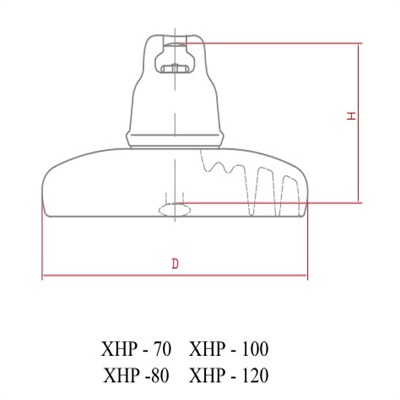
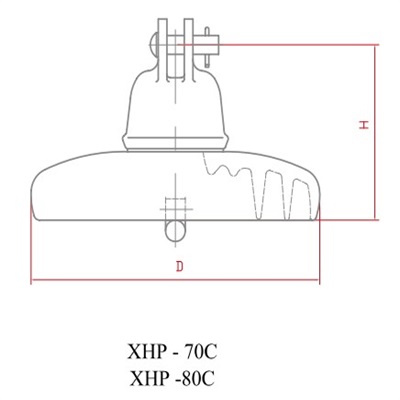
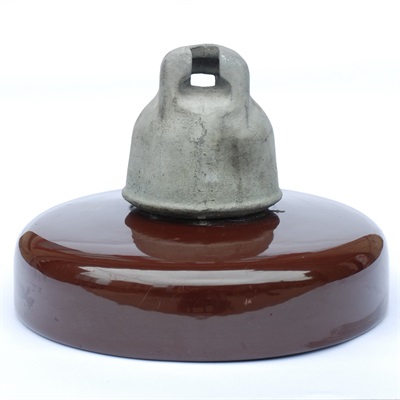

| MAIN DIMENSIONS AND STANDARD PARTICULARS | ||||||||
| Type | 52-1 | 52-2 | 52-3 | 52-4 | 52-5 | 52-6 | 52-9 | |
| Porcelain Disc Diameter,D.mm | 152 | 190 | 254 | 254 | 254 | 254 | 108 | |
| Unit Spacing,H.mm | 140 | 146 | 146 | 146 | 146 | 146 | 160 | |
| Creepage Distance,mm | 178 | 210 | 292 | 292 | 292 | 292 | 171 | |
| Combined M&E Strength,KN | 44 | 67 | 67 | 67 | 111 | 111 | 44 | |
| Impact Strength,N-m | 5 | 5.5 | 6 | 6 | 7 | 7 | 5 | |
| Routine Proof Test Load,KN | 22 | 33.5 | 33.5 | 33.5 | 55.5 | 55.5 | 22 | |
| Time Load Test Value | 27 | 44 | 44 | 44 | 67 | 67 | 27 | |
| Low Frequency Flashover Voltage | Dry, kv | 60 | 65 | 80 | 80 | 80 | 80 | 60 |
| Wet, kv | 30 | 35 | 50 | 50 | 50 | 50 | 30 | |
| Critical Impulse Flashover Voltage | Pos., kv | 100 | 115 | 125 | 125 | 125 | 125 | 100 |
| Neg., kv | 100 | 115 | 130 | 130 | 130 | 130 | 90 | |
| Low Frequency Puncture Voltage,KV | 80 | 90 | 110 | 110 | 110 | 110 | 80 | |
| Radio Influence Voltage Data | Test Voltage to Ground,KV | 7.5 | 7.5 | 10 | 10 | 10 | 10 | 7.5 |
| Max.RIV at 1000KHZ,UV | 50 | 50 | 50 | 50 | 50 | 50 | 50 | |
| Net Weight, Each Approx., kg | 2.5 | 3.5 | 4.6 | 4.6 | 5.5 | 5.5 | 2.5 | |
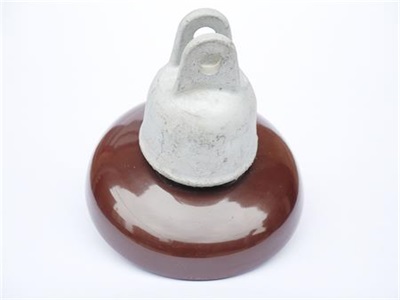
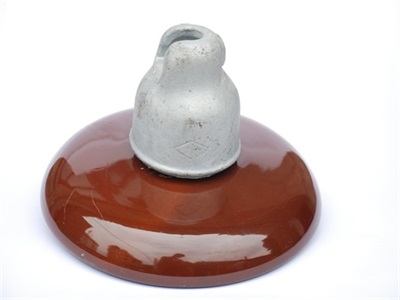
We warmly welcome friends both domestic and abroad to visit our company, if you have any questions, please contact with us directly.
Disc Insulator
Disc Insulator,Disc Type Insulator,Porcelain Disc Insulators,Suspension Disc Insulator
FUZHOU SINGREE IMP.& EXP.CO.,LTD. , https://www.cninsulators.com